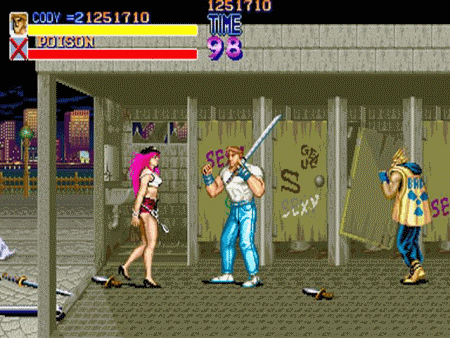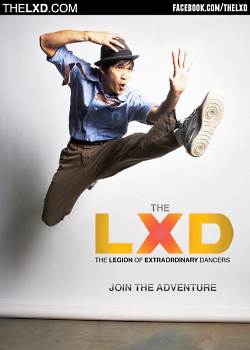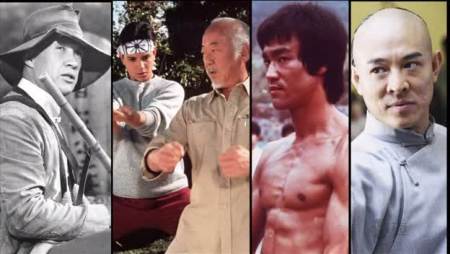
Artist: Nicki Minaj
Video: Your Love
Styles: Kenjutsu, Karate
Facts: Michael Jai White, who plays the sensei in “Your Love”, holds black belts in seven different styles of martial arts, including Tang Soo Do and Kyokushin.
Unlocking human potential through martial arts

Artist: Nicki Minaj
Video: Your Love
Styles: Kenjutsu, Karate
Facts: Michael Jai White, who plays the sensei in “Your Love”, holds black belts in seven different styles of martial arts, including Tang Soo Do and Kyokushin.

Final Fight, a classic arcade game
[Play Flash version online for free]
Your name is Cody, and you have no past, only a backstory. Some street gang kidnapped your girlfriend Jessica, you are told, and you need to punch them all out in order to rescue her. Details are not important–just start punching!
The clock is ticking, literally. You have to reach the end of each gang-infested street before the timer reaches zero, or Jessica is finished. Unfortunately you never learned to run, much less drive a car, or ride a bicycle, or even take the bus. No, Cody, you never learned much of anything in your life: all you can do now is walk around, jump, kick, punch, and “special attack.”
Lucky for you, most of the Mad Gear gang attended the same inner-city schools.

From the New York Times:
“They lie amongst us, preparing for battle, waiting to rise and change things for good. Some are gifted in ability, others are trained to master it and some, some have it bestowed upon them at birth, but they all must choose.” These words, spoken in a James Earl Jones baritone, could be the opening crawl for the latest “X-Men” movie. But they aren’t referring to traditional superheroes, at least not in the masked and overly muscled sense. They are dancers.
The lines come from the first episode of “The LXD” or “The Legion of Extraordinary Dancers,” a new dance-inspired Web series created by Jon M. Chu, the 30-year-old director of the hit 2008 movie “Step Up 2: The Streets” and the soon to be released “Step Up 3D.”
The series, which made its debut on July 7 on Hulu is produced by Mr. Chu and Hieu Ho with Agility Studios, and is a leap in Web-based original programming. “This is the most ambitious project that has been done for the Internet,” said Thomas F. Lesinski, the president of Paramount Digital Entertainment, adding later that the cinematography “could hold up in a movie theater.” New episodes will appear every Wednesday throughout the summer. Changing public perceptions about dancers was part of what Mr. Chu had in mind when he conceived the series.
“Dancers actually have a real power,” said Mr. Chu, who studied tap growing up in Palo Alto, Calif., before he fell for filmmaking, and this is how he views the dancers in the show. “Some people call it aura, some people call it chi, we call it ra,” he said. “And the ra is that power.” He added: “So when a b-boy does his spins, if you concentrate, you can see him shoot out that power, and it can affect someone physically. Or like when a ballerina cuts her leg through the air, it’s actually like a Ninja slice across someone’s face. And a jazz dancer’s jazz hands can actually rumble the floor if they know how to do it in the right way.”
“Diamond Dave, The Kung Fu Hillbilly”
At Diamond Dave’s Ninja School, you’ll learn the difference between a Ninja chop, a Judo chop, and a Karate chop.
My first experience with board breaking was a total humiliation. I was a ten-year-old Karate student, with six months of practice under my orange belt, when my sensei decided we should all break some wood. He asked each of us to acquire a stack of boards, one square foot by one inch in size, and bring them to our next class.
As a bright but naive child, I had no idea that the practice of tameshiwari, or breaking, was an instrument of martial arts fraud. I only knew that it looked cool, and that it required focus–or so my teacher said.
Patrick Swayze in Road House
 Introduction
Introduction

In a recent episode of their hit Showtime series, stage magicians Penn Jilette and Raymond Teller warn viewers away from the universally fraudulent field of martial arts. Now a real expert martial artist rescues us from their half-baked debunkings.

For their own convenience, Penn and Teller divide the world of martial arts into three categories: traditional, mystical, and murderous.
Over the past week, Seattle’s recent “jaywalking rumble” has gained worldwide interest. It has provoked a spirited debate, among martial artists and the public at large, over the limits of reasonable force. Some believe that the police officer’s punch was brutally excessive, and that some form of joint lock would have been more appropriate. The following article expresses my dissenting view.
Introduction
In the martial arts, a “joint lock” is a technique that targets a joint in an opponent’s body, holding it near or outside its normal range of motion. The purpose of a joint lock is not to inflict harm, but to issue a credible threat of harm. The recipient of a joint lock is expected to submit: to move, or to stop moving, as directed by the applicant.
Locking techniques exist for nearly every joint in the human body. Depending on the technique selected, the recipient may or may not be physically immobilized (“locked”) upon application. The recipient may or may not experience significant pain, as a signal to comply, before the onset of bone or soft tissue damage.
Joint locks can be applied in the context of combat sport, law enforcement, or self-defense. The use of joint locks is usually restricted in fighting competitions, due to the high risk of injury.
Joint Locks for Pain Compliance and Restraint
The use of the joint lock as a “nonviolent” coercion method–and an alternative to striking–is complicated by a number of factors.
Last Monday, police officer Ian Walsh observed a group of women jaywalking near MLK Way in central Seattle. He directed the women to his squad car, presumably to warn or cite them for breaking the law. They refused to cooperate.
One of the women, Marilyn Ellen Levias, decided to walk away instead. As Officer Walsh grabbed her, and the pair struggled, a crowd gathered to watch. Levias’ companion, Angel Rosenthal, shoved Walsh so that Levias could escape.
Officer Walsh responded by punching Miss Rosenthal in the face.